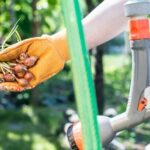Wildlife gardens play a crucial role in preserving biodiversity and creating habitats for various species. Implementing ideas for improving wildlife gardens is essential to support local ecosystems and promote a healthy environment. By incorporating strategies to attract wildlife, such as native plants, water sources, and shelters, gardeners can contribute to the conservation of wildlife populations.
From providing food sources for birds and butterflies to creating safe havens for small mammals and insects, wildlife gardens offer numerous benefits. These green spaces not only enhance the beauty of outdoor areas but also contribute to educational opportunities for individuals interested in learning more about local flora and fauna. Planning a wildlife garden requires careful consideration of location, layout, and plant selection to maximize its potential as a habitat for diverse species.
In this article, we will delve into various aspects of improving wildlife gardens, including tips on selecting native plants, incorporating water features, adding shelters like birdhouses and bee hotels, adopting wildlife-friendly garden maintenance practices like organic gardening, attracting pollinators, monitoring wildlife activity, and engaging with the community. By following these ideas and suggestions, gardeners can create thriving habitats that support biodiversity while enjoying the beauty of nature right in their backyard.
Planning Your Wildlife Garden
Considering Sunlight and Soil Conditions
When planning your wildlife garden, it is essential to consider the sunlight and soil conditions of your chosen location. Most native plants require a specific amount of sunlight to thrive, so be sure to observe how much sun each area of your garden receives throughout the day.
Additionally, understanding the soil type in your garden will help you select the right plants that can adapt well to those conditions. By choosing plants that are well-suited to your garden’s sunlight and soil conditions, you can ensure a successful wildlife-friendly space.
Creating Different Micro-Habitats
To maximize the biodiversity in your wildlife garden, consider creating different micro-habitats within your space. This can be accomplished by incorporating a variety of plant species that provide different levels of coverage and support various types of wildlife. For example, tall grasses or shrubs can provide shelter for birds and small mammals, while flowering plants attract bees and butterflies. By creating diverse micro-habitats, you can attract a wide range of wildlife species to your garden.
Designing Accessibility for Wildlife
Another important aspect to consider when planning your wildlife garden is designing accessibility for wildlife. This includes providing clear pathways for animals to move through the garden, as well as avoiding obstacles that may hinder their movement.
Additionally, incorporating features like stepping stones or shallow dishes for water can make it easier for wildlife to access essential resources within your garden. By designing with accessibility in mind, you can create a welcoming environment that encourages wildlife to visit and inhabit your space.
Selecting Native Plants
When choosing native plants for your garden, consider selecting a variety of species that bloom at different times of the year. This will ensure that there are food sources available for wildlife throughout the seasons. Additionally, incorporating a mix of flower shapes and colors can attract a diverse range of pollinators to your garden. Here are some popular native plant options to consider:
- Milkweed: A vital plant for monarch butterflies as it serves as a host plant for their caterpillars
- Goldenrod: Attracts bees and provides late-season nectar sources
- Native grasses: Provide cover and nesting material for birds
- Coneflowers: Loved by pollinators such as bees and butterflies
Native plants not only benefit wildlife but also require less maintenance compared to non-native species once established in your garden. They are well-suited to the local climate and soil conditions, making them more resilient to pests and diseases. By planting native species, you can create a beautiful and functional garden that contributes to preserving the natural heritage of your area.
Providing Water Sources
Water sources are essential components of a thriving wildlife garden, providing much-needed hydration for local fauna and attracting a diverse range of species to your outdoor space. Incorporating water features into your garden can be a rewarding experience that not only benefits wildlife but also enhances the beauty of your landscape.
One simple way to provide water for wildlife is by installing a birdbath, which can attract birds for drinking and bathing. Make sure to keep the birdbath clean and filled with fresh water to encourage frequent visits from our feathered friends.
Another option for incorporating water into your garden is by adding a small pond or shallow pool. These features can support a variety of aquatic creatures like frogs, newts, and dragonflies, adding another dimension of biodiversity to your garden.
Consider planting aquatic plants around the edges of the pond to provide shelter and food sources for these water-loving animals. Additionally, introducing a rain barrel or rain chain can help collect rainwater for use in watering your plants while also offering a drinking spot for wildlife.
It’s important to remember that all wildlife needs access to clean water in order to survive, so ensuring that your water features are well-maintained is crucial. Regularly cleaning out debris and algae build-up from ponds and keeping birdbaths filled with fresh water will go a long way in supporting the health of the wildlife visiting your garden.
By prioritizing the provision of water sources in your wildlife-friendly garden, you can create a welcoming oasis for local species while enjoying the sight and sounds of nature right outside your door.
Creating Shelter
When it comes to wildlife gardens, providing shelters for animals is essential to creating a welcoming and safe environment for them. One popular way to do this is by adding birdhouses and bee hotels to your garden. Birdhouses provide nesting spots for various bird species, while bee hotels offer solitary bees a place to rest and reproduce. These shelters not only benefit the wildlife in your garden but also add a charming aesthetic element to your outdoor space.
When setting up birdhouses, consider the types of birds that are common in your area and choose designs that cater to their specific needs. Different bird species have different entrance hole sizes and interior dimensions requirements, so it’s important to do some research before installing birdhouses in your garden.
Similarly, bee hotels should be placed in sunny areas with protection from wind and rain. You can create DIY bee hotels using hollow bamboo sticks or purchase pre-made ones online or from local garden centers.
In addition to birdhouses and bee hotels, you can also add other types of shelters like hedgehog houses, bat boxes, or butterfly hibernation boxes to diversify the habitats available in your wildlife garden. These shelters provide refuge for various creatures throughout the year, especially during harsh weather conditions or mating seasons. By incorporating a variety of shelters into your garden design, you can attract a wider range of wildlife species and create a more balanced ecosystem in your backyard.
| Shelter Type | Beneficiary Wildlife |
|---|---|
| Birdhouse | Birds |
| Bee Hotel | Bees |
| Hedgehog House | Hedgehogs |
| Bat Box | Bats |
Wildlife-Friendly Garden Maintenance
In addition to using organic methods for soil enrichment, it is essential to practice integrated pest management (IPM) techniques in your wildlife garden. Instead of resorting to chemical pesticides that can harm beneficial insects and wildlife, consider natural alternatives like neem oil or insecticidal soaps to control pests effectively. Introducing predatory insects or planting companion plants that repel pests can also help maintain a balanced ecosystem without compromising the health of your garden.
Moreover, regular observation and monitoring of your wildlife garden are vital for identifying any potential issues early on and taking proactive measures to address them. By staying attuned to changes in plant health, insect activity, and wildlife behavior, you can make informed decisions about how to improve the overall well-being of your garden. Engaging in sustainable gardening practices not only benefits the local wildlife but also contributes to the conservation of biodiversity in your community.
| Organic Gardening Practices | Avoiding Pesticides |
|---|---|
| Use natural fertilizers, compost, and mulch | Practice integrated pest management (IPM) |
| Implement soil enrichment techniques without synthetic chemicals | Consider natural alternatives like neem oil or insecticidal soaps |
| Utilize predator insects or companion plants for pest control | Regular observation and monitoring for early issue detection |
Attracting Pollinators
Planting Pollinator-Friendly Plants
One of the most effective ways to attract bees, butterflies, and other pollinators to your wildlife garden is by planting a variety of flowers that provide nectar and pollen. Selecting a diverse range of native plants that bloom at different times throughout the year can help ensure a steady food supply for pollinators.
Some popular choices include coneflowers, milkweed, lavender, and bee balm. By creating a habitat rich in nectar-rich flowers, you can encourage pollinators to visit your garden regularly.
Creating Habitat Diversity
In addition to planting pollinator-friendly plants, it’s essential to create a variety of habitats within your wildlife garden to attract a diverse range of pollinators. Incorporating features such as rock piles, log piles, and wild grassy areas can provide nesting sites and shelter for bees and butterflies.
Adding blooming shrubs and trees can also attract different types of pollinators to your garden. By offering a mix of habitats, you can cater to the specific needs of various pollinator species.
Avoiding Chemical Pesticides
To truly make your garden inviting to bees, butterflies, and other pollinators, it’s crucial to avoid using chemical pesticides and herbicides. These toxic substances not only harm pests but can also negatively impact beneficial insects like bees and butterflies. Instead, opt for organic pest control methods like handpicking insects or using natural predators such as ladybugs. By maintaining a pesticide-free environment in your wildlife garden, you can protect pollinators and create a healthy ecosystem for them to thrive.
Monitoring and Adapting
Here are some ideas for improving wildlife gardens through monitoring and adapting:
- Create a wildlife logbook or journal to keep track of species sightings, behaviors, and any changes you notice over time.
- Use bird feeders and baths to attract different bird species and observe their interactions.
- Plant a variety of flowers that bloom at different times of the year to provide nectar sources for pollinators throughout all seasons.
By making small changes based on your observations, you can create a more diverse and thriving ecosystem in your wildlife garden. Remember that every action counts when it comes to supporting local wildlife populations.
Additionally, consider reaching out to local wildlife experts or organizations for guidance on monitoring techniques and conservation efforts in your area. Collaborating with like-minded individuals can help amplify the impact of your wildlife garden and contribute to broader conservation initiatives within the community. Together, we can create spaces that not only benefit wildlife but also inspire others to take action in creating sustainable habitats for all living creatures.
Engaging With the Community
One of the most valuable aspects of creating a wildlife garden is the opportunity to engage with the community and spark interest in conservation efforts. By involving neighbors and local organizations in the process, you can create a network of like-minded individuals who are committed to supporting biodiversity and creating wildlife-friendly spaces.
To start, consider hosting a neighborhood gathering or workshop to share ideas and resources for improving wildlife gardens. This can be a great way to exchange tips on plant selection, gardening practices, and wildlife conservation. By building a sense of community around the shared goal of creating habitats for local wildlife, you can inspire others to take action in their own yards and green spaces.
Furthermore, collaborating with local organizations such as nature centers, botanical gardens, or environmental groups can provide additional support and resources for your wildlife garden project. These partnerships can lead to educational opportunities, volunteer events, and even funding for larger-scale habitat restoration projects. By working together with like-minded individuals and organizations, you can create a ripple effect of positive change that benefits both wildlife and the community as a whole.
In conclusion, by engaging with the community and fostering a sense of shared responsibility for creating wildlife-friendly spaces, you can amplify the impact of your efforts and inspire others to join in preserving biodiversity. Through collaboration, education, and collective action, we can create interconnected networks of thriving habitats that support native pollinators, birds, mammals, and other wildlife species.
Together, we can make a difference in our communities and contribute to a healthier environment for all living beings. Let’s continue sharing our passion for nature and inspiring others to embrace ideas for improving wildlife gardens in their own backyards.
Frequently Asked Questions
How Can I Improve My Garden Area?
Improve your garden area by creating a diverse habitat for plants and flowers, considering the needs of pollinators, introducing native species, and using sustainable gardening practices. Adding bird feeders or houses can also attract wildlife.
What Can Be Done to Encourage Wildlife?
To encourage wildlife in your garden, you can incorporate features such as bird baths, feeders, nesting boxes, and bee hotels. Planting a variety of flowers and shrubs that provide food and shelter will attract different species of birds, insects, and small animals.
How Do I Make My Yard Wildlife-Friendly?
Making your yard wildlife-friendly involves creating a welcoming environment for animals by providing food sources like birdseed, nectar-rich flowers for pollinators, and water features like birdbaths or ponds. Avoiding the use of pesticides and chemicals will help protect wildlife in your yard.

Welcome to my gardening blog! I am passionate about plants and enjoy sharing my knowledge and experiences with others. In this blog, I will write about everything related to gardening, from tips on how to get started to updates on my own garden projects.





